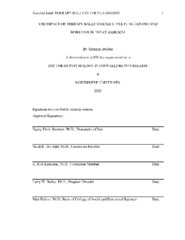The Impact of Therapy Balls on Executive Functioning and behavior in the Classroom
Abstract
The purpose of this dissertation is to determine the impact on children's executive functioning and self-esteem when therapy balls are used in the classroom instead of traditional seating. An experimental, within subject design was implemented using 44 children. There were six assessments: the Behavioral Rating Inventory of Executive Functioning (BRIEF) scale, two scales of the Wechsler Intelligence Scale for Children -Fourth Edition (WISC-IV), the Culture Free Self-Esteem Inventory -Third Edition (CFSEI-3), a questionnaire regarding students' peer relations, and a student and teacher questionnaire regarding preference of chairs versus therapy balls. The results showed that children significantly improved in working memory and processing speed as measured by the WISC-IV. Furthermore, the children displayed significantly reduced hyperactivityimpulsivity and improved monitoring abilities as measured by the BRIEF. Children also significantly improved in self-esteem as measured by the CFSEI-3. Despite these developments, teachers rated the children as having improved minimally, not significantly, in attention. There were no significant gender findings. Additionally, the children preferred therapy balls over chairs, but the teachers did not. Finally, where past research mainly revealed students with attention deficit hyperactivity disorder (ADHD) or autism spectrum disorder (ASD) benefitting most from therapy balls, this study showed that typical and atypical children significantly improved. Ultimately, this study has shown that classrooms can be modified to give all children more liberty of movement while seated at their desks, resulting in more optimal learning, and improved self-esteem.
Original item type
PDF
Original extent
66 pages
Collections
Copyright
This original work is protected by copyright. Copyright is retained by the author(s). Works may be viewed, downloaded, or printed, but not reproduced or distributed without author(s) permission.


 Maintained by the Northwest University Library
Maintained by the Northwest University Library